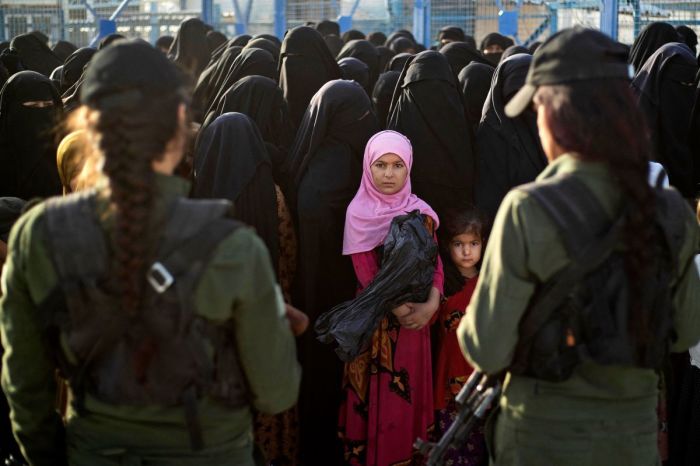
Fears are mounting that Islamic State fighters are regrouping in Syria and Iraq, exploiting security gaps to revive operations and launch attacks. Intelligence and military sources are concerned the group is moving weapons, activating sleeper cells and recruiting amid reduced U.S. troop presence and political instability.
More than 20 sources, including regional diplomats and officials from Syria, Iraq, the United States and Europe, voiced concern to Reuters that IS (also known as ISIS or ISIL) is attempting to stage a comeback after its territorial defeat in 2017.
In recent months, IS has shifted personnel from remote desert areas to urban centers such as Deir al-Zor, Hasakah and Kirkuk, targeting oil facilities, power lines and other vulnerable infrastructure, according to the Straight Arrow News. Sleeper cells have reemerged in these cities, taking advantage of scaled-down coalition patrols in eastern Syria.
A January report from the Critical Threats Project at the American Enterprise Institute warned that IS “gradually rebuilt its capabilities since 2022 in the central Syrian desert — where regime forces infrequently and ineffectively patrolled — and gradually infiltrated then-regime-held towns along the Euphrates River.”
“Neither the Assad regime nor Russian forces prioritized defeating ISIS and instead focused on suppressing threats to Assad’s rule,” the report stated.
Deir al-Zor and Hasakah lie in northeastern Syria, while Kirkuk is located in northern Iraq. All three are situated along key transit routes and have historically served as logistical and recruitment hubs for IS. Their proximity to oil infrastructure, porous borders and zones of weak state control make them ideal staging grounds for attacks and arms movement.
Iraqi officials have reported heightened IS activity in the Hamrin Mountains and along key supply routes.
Ali al-Saidi, an advisor to Iraqi forces, told Reuters surveillance had detected increased IS activity in the area, and sources fear fighters are transporting explosives and weapons in these areas. Security forces in Syria and Iraq say they have foiled at least a dozen major plots this year.
In one case in December, IS commanders in Syria dispatched two envoys to Iraq with orders to activate sleeper cells, five Iraqi officials told the news agency. The envoys were stopped at a checkpoint in northern Iraq on Dec. 2. Based on intelligence from their capture, Iraqi forces tracked a suspected suicide bomber to a crowded restaurant in Daquq and killed him before he could detonate his explosives.
Colonel Abdul Ameer al-Bayati of Iraq’s 8th Division told the newswire that IS elements had been “emboldened by the chaos in Syria.” Iraqi Foreign Minister Fuad Hussein confirmed that Baghdad is in contact with Damascus about cross-border IS movement and warned that Syria risks becoming a base for new attacks.
Though IS activity has risen, the number of attacks the group claims responsibility for has dropped. In the first five months of 2025, IS claimed 38 attacks in Syria and four in Iraq, according to SITE Intelligence Group.
At that rate, Syria would see about one-third as many IS-claimed incidents as in 2024. SITE’s director, Rita Katz, told Reuters the drop likely reflects a tactical shift, not a decline in capability, and that the group may be “re-strategizing.”
Reuters reports that IS has moved fighters and arms into other cities, including Aleppo, Homs, and Damascus, since the fall of former Syrian President Bashar al-Assad last December.
On May 14, Syria’s interim government raided IS hideouts in Aleppo, killing three militants and detaining four others. Interior Minister Anas Khattab called IS one of the country’s top security threats in an interview with state-owned television.
U.S. military officials estimated last July that there were about 2,500 IS fighters “at large across Iraq and Syria.” U.S. Central Command said in March that recent airstrikes had killed several mid-level IS planners. But concerns are mounting over the ability of Syria’s new leadership to maintain control as U.S. forces withdraw.
Ahmed al-Sharaa, Syria’s new Islamist leader, has pledged to bolster domestic intelligence. His interim government is facing pressure from both Western allies and hardline factions.
Following a meeting with U.S. President Donald Trump in May, IS denounced Sharaa in its al-Naba publication and urged foreign fighters in Syria to join its ranks. Intelligence sources have tracked a small number of suspected foreign fighters entering Syria from Europe in recent months.
There have also been at least two attempted jailbreaks from prisons and detention camps holding IS members and their families, according to the Kurdish-led Syrian Democratic Forces, who continue to guard these facilities.
With the U.S. reducing its footprint, questions remain about whether Damascus can assume responsibility for securing these camps.
Washington is monitoring Sharaa’s administration, but limited intelligence sharing with Damascus has occurred, a U.S. defense official was quoted as saying.
While the U.S. continues targeted strikes when actionable intelligence is available, routine air support and patrols in eastern Syria have declined. The SDF now handles most ground operations.
In Iraq, the U.S. retains an advisory presence of about 2,500 troops. Coalition operations are expected to wind down by September, but a second U.S. official told Reuters that Iraqi leaders have requested a slower withdrawal due to concerns that Assad’s collapse may have opened a corridor for weapons smuggling and infiltration.
No officials currently believe IS can reestablish territorial control, but analysts and military leaders agree that a prolonged insurgency remains a credible threat if left unchecked.
“ISIS cannot yet seize ground, nor can it mount months-long campaigns, but it will certainly attempt to marshal the resources to seize ground and launch major campaigns in the coming months and years unless it is prevented from doing so,” according to the Critical Threats Project.
In late May, IS claimed responsibility for its first two attacks targeting Syria’s transitional government, claiming to have killed or injured seven members of what it referred to as an “apostate Syrian regime.”
Concerns have also been raised about the pro-IS sentiments within the al Hol and Roj detention camps in northeast Syria, which house over 55,000 detainees who are primarily women and children associated with IS. Many of the children have spent their entire lives in captivity and have exhibited violent tendencies, such as mimicking the radicalized behavior of their parents. Some fear they are breeding grounds for the “next cubs of the caliphate.”


















